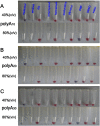Quantitative investigation of the poly-adenine DNA dissociation from the surface of gold nanoparticles
- PMID: 25974839
- PMCID: PMC4431394
- DOI: 10.1038/srep10158
Quantitative investigation of the poly-adenine DNA dissociation from the surface of gold nanoparticles
Abstract
In recent years, poly adenine (polyA) DNA functionalized gold nanoparticles (AuNPs) free of modifications was fabricated with high density of DNA attachment and high hybridization ability similar to those of its thiolated counterpart. This nanoconjugate utilized poly adenine as an anchoring block for binding with the AuNPs surface thereby facilitated the appended recognition block a better upright conformation for hybridization, demonstrating its great potential to be a tunable plasmonic biosensor. It's one of the key points for any of the practical applications to maintaining stable conjugation between DNA oligonucleotides and gold nanoparticles under various experimental treatments. Thus, in this research, we designed a simple but sensitive fluorescence turn-on strategy to systematically investigate and quantified the dissociation of polyA DNA on gold nanoparticles in diverse experimental conditions. DNA desorbed spontaneously as a function of elevated temperature, ion strength, buffer pH, organic solvents and keeping time. What's more, evaluating this conjugate stability as affected by the length of its polyA anchor was another crucial aspect in our study. With the improved understanding from these results, we were able to control some of our experimental conditions to maintain a good stability of this kind of polyA DNA-AuNPs nanoconjugates.
Figures





Similar articles
-
Designed diblock oligonucleotide for the synthesis of spatially isolated and highly hybridizable functionalization of DNA-gold nanoparticle nanoconjugates.J Am Chem Soc. 2012 Jul 25;134(29):11876-9. doi: 10.1021/ja304118z. Epub 2012 Jul 16. J Am Chem Soc. 2012. PMID: 22799460
-
PolyA-Mediated DNA Assembly on Gold Nanoparticles for Thermodynamically Favorable and Rapid Hybridization Analysis.Anal Chem. 2016 May 3;88(9):4949-54. doi: 10.1021/acs.analchem.6b00891. Epub 2016 Apr 22. Anal Chem. 2016. PMID: 27058116
-
Self-assembly of poly-adenine-tailed CpG oligonucleotide-gold nanoparticle nanoconjugates with immunostimulatory activity.Small. 2014 Jan 29;10(2):368-75. doi: 10.1002/smll.201300903. Epub 2013 Aug 21. Small. 2014. PMID: 23963797
-
Construction and bioanalytical applications of poly-adenine-mediated gold nanoparticle-based spherical nucleic acids.Anal Methods. 2023 Nov 2;15(42):5564-5576. doi: 10.1039/d3ay01618h. Anal Methods. 2023. PMID: 37861233 Review.
-
Design and applications of gold nanoparticle conjugates by exploiting biomolecule-gold nanoparticle interactions.Nanoscale. 2013 Apr 7;5(7):2589-99. doi: 10.1039/c3nr33870c. Nanoscale. 2013. PMID: 23423633 Review.
Cited by
-
Simultaneous colorimetric determination of morphine and ibuprofen based on the aggregation of gold nanoparticles using partial least square.J Pharm Anal. 2017 Dec;7(6):411-416. doi: 10.1016/j.jpha.2017.03.001. Epub 2017 Mar 14. J Pharm Anal. 2017. PMID: 29404068 Free PMC article.
-
JEV-nanobarcode and colorimetric reverse transcription loop-mediated isothermal amplification (cRT-LAMP).Mikrochim Acta. 2021 Sep 8;188(10):333. doi: 10.1007/s00604-021-04986-9. Mikrochim Acta. 2021. PMID: 34498149
-
Non-PCR Ultrasensitive Detection of Viral RNA by a Nanoprobe-Coupling Strategy: SARS-CoV-2 as an Example.Adv Healthc Mater. 2022 Sep;11(17):e2200031. doi: 10.1002/adhm.202200031. Epub 2022 Jun 19. Adv Healthc Mater. 2022. PMID: 35678310 Free PMC article.
-
Effect of Fluorescent Labels on DNA Affinity for Gold Nanoparticles.Nanomaterials (Basel). 2021 Apr 29;11(5):1178. doi: 10.3390/nano11051178. Nanomaterials (Basel). 2021. PMID: 33947157 Free PMC article.
-
Non-Covalent Associates of siRNAs and AuNPs Enveloped with Lipid Layer and Doped with Amphiphilic Peptide for Efficient siRNA Delivery.Int J Mol Sci. 2018 Jul 19;19(7):2096. doi: 10.3390/ijms19072096. Int J Mol Sci. 2018. PMID: 30029512 Free PMC article.
References
-
- Aldaye F. A., Palmer A. L. & Sleiman H. F. Assembling materials with DNA as the guide. Science 321, 1795–1799 (2008). - PubMed
-
- Gothelf K. V. & LaBean T. H. DNA-programmed assembly of nanostructures. Org. Biomol. Chem. 3, 4023–4037 (2005). - PubMed
-
- Liu D., Cheng E. & Yang Z. DNA-based switchable devices and materials. NPG Asia Mater. 3, 109–114 (2011).
-
- Seeman N. C. DNA in a material world. Nature 421, 427–431 (2003). - PubMed
Publication types
MeSH terms
Substances
LinkOut - more resources
Full Text Sources
Other Literature Sources

